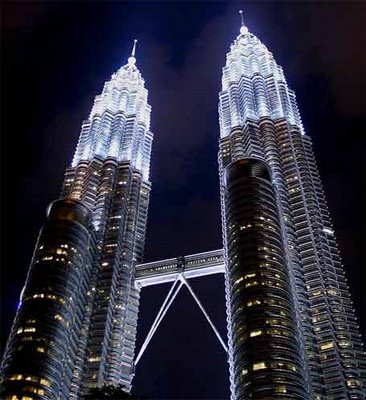
Below the twin towers is Suria KLCC, a shopping mall, and Dewan Filharmonik Petronas, the home of the Malaysian Philharmonic Orchestra. ...
en.wikipedia.org/wiki/Petronas_Twin_Towers
PETRONAS
Click the button below to install the plugin. click here to get the Flash-plug-in · Click here to Enter PETRONAS Corporate Website.
www.petronas.com.my/

http://greenstructures.wordpress.com/2009/08/12/top-five-tallest-buildings/
Petronas Twin Towers Malaysia
The Petronas Twin Towers (Malay: Menara Berkembar Petronas) (also known as the Petronas Towers or just Twin Towers), in Kuala Lumpur, Malaysia are twin towers and were the world's tallest buildings before being surpassed by Taipei 101. However, the towers are still the tallest twin buildings in the world. They were the world's tallest buildings from 1998 to 2004 if measured from the level of the main entrance to the structural top, the original height reference used by the international organization Council on Tall Buildings and Urban Habitat from 1969 (three additional height categories were introduced as the tower neared completion in 1996).
Comparison with other towers
In accordance to CTBUH, the pinnacles contributed to the overall height of the towers, thus surpassing the Willis Tower.
The Petronas Twin Towers were the tallest buildings in the world until Taipei 101 was completed in 2004, as measured to the top of their structural components (spires, but not antennas).Spires are considered integral parts of the architectural design of buildings, to which changes would substantially change the appearance and design of the building, whereas antennas may be added or removed without such consequences. The Petronas Twin Towers remain the tallest twin buildings in the world.
The Willis Tower and the World Trade Center towers were each constructed with 110 occupied floors – 22 more than the Petronas Twin Towers’ 88 floors. The Willis Tower and the World Trade Center’s roofs and highest occupied floors substantially exceeded the height of the roof and highest floors of the Petronas Twin Towers. The Willis Tower’s tallest antenna is 75 m (246 ft) taller than the Petronas Twin Towers’ spires. However, in accordance to CTBUH regulations and guidelines, the antennas of the Willis Tower were not counted as part of its architectural features. The spires on the Petronas Towers are included in the height since they are not antenna masts. Therefore, the Petronas Twin Towers exceed the official height of the Willis Tower by 10 m, but the Willis Tower has more floors and much higher square footage.
History
Designed by Argentine-American architect César Pelli, the Petronas Towers were completed in 1998 after a seven year build and became the tallest buildings in the world on the date of completion They were built on the site of Kuala Lumpur's race track.Because of the depth of the bedrock, the buildings were built on the world's deepest foundations. The 120-meter foundations were built within 12 months by Bachy Soletanche, and required massive amounts of concrete.
The 88-floor towers are constructed largely of reinforced concrete, with a steel and glass facade designed to resemble motifs found in Islamic art, a reflection of Malaysia's Muslim religion.[10] Another Islamic influence on the design is that the cross section of the towers is based on a Rub el Hizb (albeit with circular sectors added to meet office space requirements).
Due to a lack of steel and the huge cost of importing steel, the towers were constructed on a cheaper radical design of super high-strength reinforced concrete.[12] High-strength concrete is a material familiar to Asian contractors and twice as effective as steel in sway reduction; however, it makes the building twice as heavy on its foundation than a comparable steel building. Supported by 23-by-23 meter concrete cores[13] and an outer ring of widely spaced super columns, the towers use a sophisticated structural system that accommodates its slender profile and provides 560,000 square metres of column-free office space.[14] Below the twin towers is Suria KLCC, a shopping mall, and Dewan Filharmonik Petronas, the home of the Malaysian Philharmonic Orchestra.
Other buildings have used spires to increase their height but have always been taller overall to the pinnacle when trying to claim the title. In the aftermath of the controversy, the rules governing official titles were partially overhauled, and a number of buildings re-classified structural antenna as architectural details to boost their height rating (even though nothing was actually done to the building).
http://en.wikipedia.org/wiki/Petronas_Twin_Towers
http://architecture.desktopnexus.com/wallpaper/70087/




